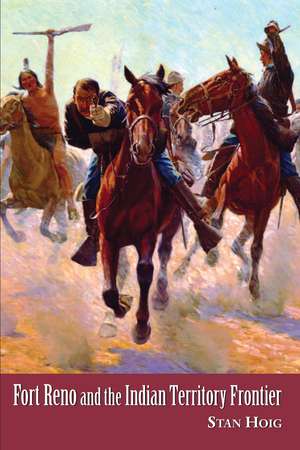Fort Reno and the Indian Territory Frontier
Autor Stan Hoigen Limba Engleză Paperback – oct 2005
The story of Fort Reno, as detailed here by Stan Hoig, touches on several of the most important topics of nineteenth-century Western history: the great cattle drives, Indian pacification and the Plains Wars, railroads, white settlement, and the Oklahoma land rushes. Hoig deals not only with Fort Reno, but also with Darlington agency, the Chisolm Trail, and the trading activities in Indian Territory from 1874 to approximately 1900. The author includes maps, photographs, and illustrations to enhance the narrative and guide the reader, like a scout, through a time of treacherous but fascinating events in the Old West.
Preț: 152.33 lei
Preț vechi: 216.96 lei
-30% Nou
Puncte Express: 228
Preț estimativ în valută:
29.15€ • 30.43$ • 24.12£
29.15€ • 30.43$ • 24.12£
Carte indisponibilă temporar
Doresc să fiu notificat când acest titlu va fi disponibil:
Se trimite...
Preluare comenzi: 021 569.72.76
Specificații
ISBN-13: 9781557288097
ISBN-10: 1557288097
Pagini: 298
Dimensiuni: 152 x 229 x 23 mm
Greutate: 0.51 kg
Editura: University of Arkansas Press
Colecția University of Arkansas Press
ISBN-10: 1557288097
Pagini: 298
Dimensiuni: 152 x 229 x 23 mm
Greutate: 0.51 kg
Editura: University of Arkansas Press
Colecția University of Arkansas Press
Recenzii
“A comprehensive, yet easy to read account. . . . His stories of Indian chiefs, Boomers and Sooners, dedicated missionaries and gala Fourth of July horse races paint a vivid mural of the robust years of Fort Reno and what would someday become Oklahoma.”
—The Sunday Oklahoman
“Not only a good read, but a real contribution to military history.”
—True West
“Informative and readable. . . . Hoig places the history of Fort Reno in the context of significant topics of American westward expansion: Indian wars, Unisted States–Indian relations, cattle drives, railroads, white settlement, and the Oklahoma land rushes. Numerous maps, photographs, and illustrations augment his skillful narrative.”
—Montana: The Magazine of Western History
“Fort Reno participated in a series of major events that marked the end of the frontier era. . . Utilizing a vast array of manuscript collections, government documents, and other published sources, Hoig has crafted an exciting and accurate tale of Indian—white conflict and cooperation at the end of the 19th century.”
—Choice Magazine
“An excellent account . . . an outstanding history of a western fort that dealt with many of the changes experienced in the American West.”
—Military History of the West
“Hoig’s insight is that Fort Reno can be seen as a kind of pivot for events between 1874 and the early twentieth century. It is not a pretty story, but it’s an important and interesting one, and I think readers will find Hoig’s telling of it valuable.”
—Elliott West, author of The Contested Plains
—The Sunday Oklahoman
“Not only a good read, but a real contribution to military history.”
—True West
“Informative and readable. . . . Hoig places the history of Fort Reno in the context of significant topics of American westward expansion: Indian wars, Unisted States–Indian relations, cattle drives, railroads, white settlement, and the Oklahoma land rushes. Numerous maps, photographs, and illustrations augment his skillful narrative.”
—Montana: The Magazine of Western History
“Fort Reno participated in a series of major events that marked the end of the frontier era. . . Utilizing a vast array of manuscript collections, government documents, and other published sources, Hoig has crafted an exciting and accurate tale of Indian—white conflict and cooperation at the end of the 19th century.”
—Choice Magazine
“An excellent account . . . an outstanding history of a western fort that dealt with many of the changes experienced in the American West.”
—Military History of the West
“Hoig’s insight is that Fort Reno can be seen as a kind of pivot for events between 1874 and the early twentieth century. It is not a pretty story, but it’s an important and interesting one, and I think readers will find Hoig’s telling of it valuable.”
—Elliott West, author of The Contested Plains
Notă biografică
Stan Hoig is professor emeritus of journalism at the University of Central Oklahoma. He is author or editor of many other publications, including The Peace Chiefs of the Cheyennes and The Cherokees and Their Chiefs: In the Wake of Empire, which was a History Book Club selection.
